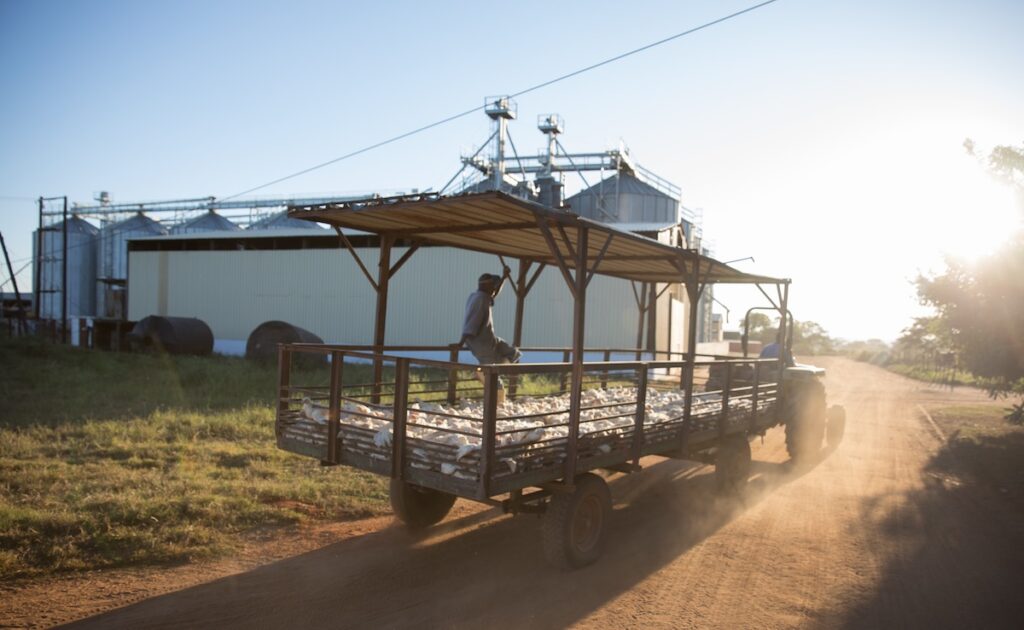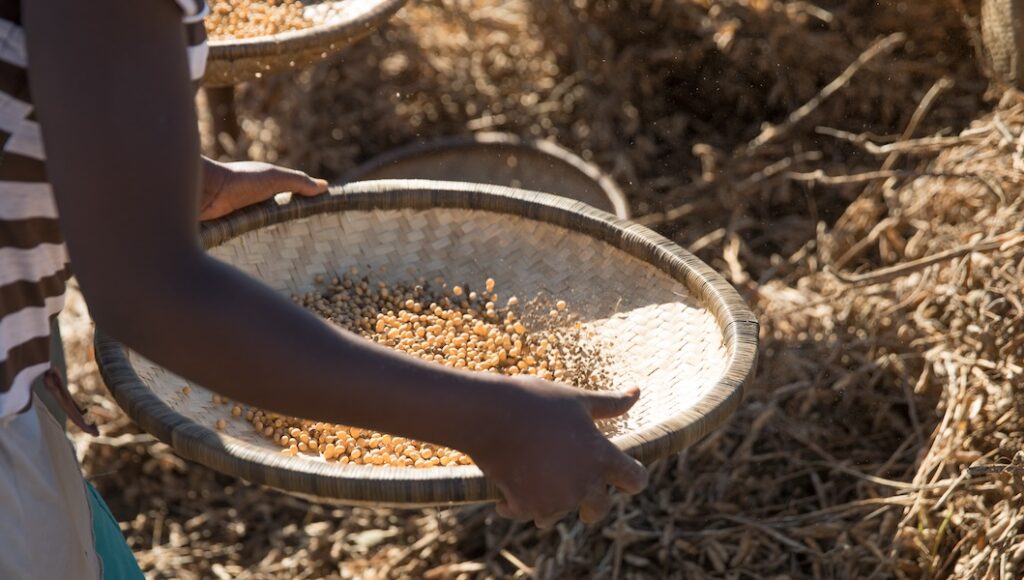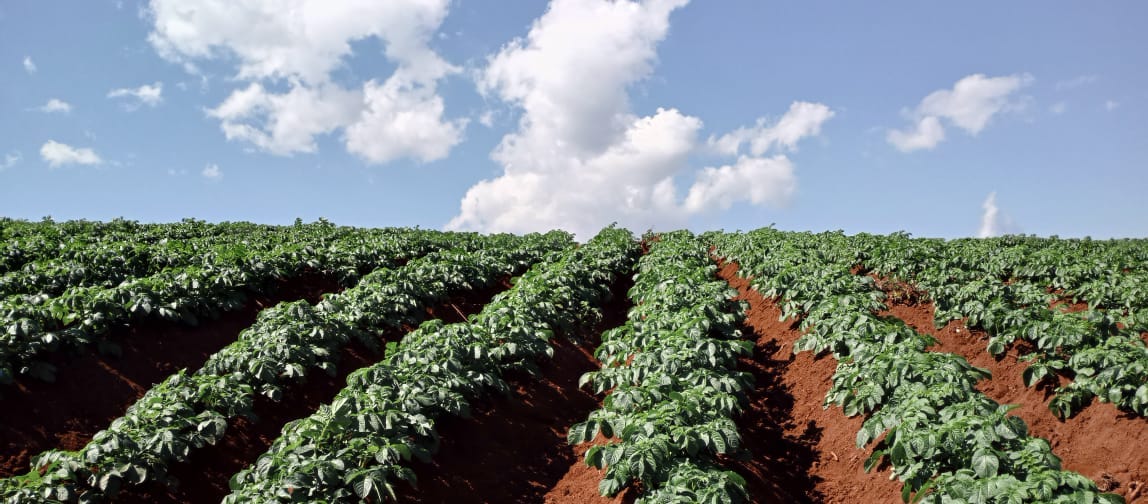Zambia has approximately 40 million hectares of arable land, but less than 14 percent of this is cultivated.1 This may seem like an opportunity to scale up production, but numerous challenges within the agricultural sector hinder the country from cultivating more of its land, adversely affecting livelihoods and food security in the Southern African nation.
Most of Zambia’s farmers are smallholder farmers, and they produce close to 80 percent of the country’s food.2 However, climate change, inaccessible financial services, and poor production practices negatively affect productivity and profitability. Over the years, this has resulted in a decline of agriculture’s contribution to GDP from 9.4 percent in 2010 to 3.09 percent in 2022.3
Producing below capacity isn’t the only problem faced by the land-locked country, as only a fraction of harvests complete the journey from farm to fork. Currently, post-harvest losses range between 30 percent and 40 percent,4. Post-harvest losses jeopardize the income and livelihoods of farmers and other stakeholders in the value chain, negatively affecting rural and economic development.

Food waste and food security
Food security in Zambia, already strained by climate change, is further weakened by post-harvest losses. Plus, deteriorating food waste emits greenhouse gases that further contribute to climate change.
Most post-harvest losses occur on the farm as a result of poor harvesting techniques and inadequate storage infrastructure. Fruits and vegetables require optimal storage and transportation conditions without which they will most likely spoil before reaching the consumer.
If the produce reaches food processors, significant waste occurs during handling and processing of raw products and the discarding of edible by-products, especially in smaller facilities where agro-processors rely heavily on manual labour.

Transport failures lead to food spoilage
Zambia’s underdeveloped transport network and poor road conditions hinder the timely delivery of farm produce, with most farms located far from markets and food processors. This remoteness, combined with inadequate infrastructure, results in long journeys that increase food waste through spoilage and physical damage during transport.
Additionally, the distance from farm to market drives up the cost of transport. As a result, many farmers elect to sell their produce closer to home, these lack proper storage facilities. The oversupply in these markets means that vendors have to lower prices to avoid losses, resulting in lower income for farmers.
Since early 2024, the country has had rolling blackouts which started with three hours of power cuts daily and has progressively worsened so that in the present Zambia now suffers from 18 to 36 hour blackouts. Load shedding, a rationing of electricity, has aggravated food waste as most businesses and households cannot afford alternative sources of power to store and cook food, and have had to regularly discard spoiled food.
While the factors causing post-harvest losses are complex and interdependent, there are some low-hanging fruits we can pick to maximize the farmers’ and country’s earning potential.
Sheila Garakara, Solidaridad’s Country Manager for Zambia
Improved harvested handling and packaging
Training farmers and handlers on improved harvesting, handling and packaging techniques will ensure that a higher quantity and quality of the harvest is available to the market. This requires civil society organizations and the government to take a coordinated approach to their capacity building efforts, sowing seeds of knowledge far and wide, while engaging private sector actors to leverage their resources and post-harvest management expertise.
Improving infrastructure and organizing farmers
To address the lack of infrastructure, such as cold storage facilities and other large equipment, farmers should be encouraged to cluster and source financing to erect shared facilities.
This type of coordination has two benefits: the first is that formal financial institutions rarely lend to individual smallholder farmers, and when they do, individual smallholder farmers cannot afford the cost of borrowing. By forming a cooperative or similar formal group, farmers can access formal financial services and share the cost. Secondly, they can also jointly utilize equipment and reduce individual costs of maintenance.
Focus on value addition
A further reduction of post-harvest losses can be achieved by teaching farmers simple on-farm value addition methods like smoking and dehydration. Finally, agro-processing is the biggest manufacturing sector in Zambia5 so there is a large appetite for fresh and dry produce. Linking smallholder farmers to processors guarantees farmers a stable income, and the manufacturer benefits from the reduced cost of locally sourced inputs.
The basket of mid- to long-term solutions that will alleviate post-harvest losses includes several items. Improving market access is key in eliminating losses, thus local governments should allocate space and capital to build more markets and equip both new and existing markets with sufficient and sanitary storage structures.

Zambia’s government can lessen losses by intervening at various points along the value chain by:
- Improving ICT connectivity in rural areas so farmers can utilise mobile apps and sensors to support production and post-harvest processes.
- Investing in developing the rail and road networks to facilitate the efficient transportation of food, resulting in more affordable transport costs and less spoilage.
Lastly, the formulation of robust post-harvest management policies and regulations can aid the reduction of post-harvest losses. The immediate benefit of lowering post-harvest losses is higher earnings and improved livelihoods for all participants in the value chain, who are approximated to be 70 percent of the population.6
These higher earnings gradually translate to rural and economic development in the low-income country. Reducing post-harvest losses alleviates food insecurity and food scarcity, consequently improving the affordability of staple and other food.
When local demand for nutritious food is satisfied, then the surplus can be exported, (on condition that transport network challenges are adequately addressed) taking advantage of continental and global trade agreements. An overall reduction of post-harvest losses can enhance food security and accelerate the agricultural sector’s contribution to Zambia’s GDP.
- International Trade Administration (https://www.trade.gov/country-commercial-guides/zambia-agriculture)
- Food and Agriculture Organization (https://www.fao.org/agriculture/ippm/projects/zambia/ru)
- International Monetary Fund (Boosting Productivity and Enhancing Climate Resilience in Zambia’s Agricultural Sector)
- African Union (Dakar2Zambia, Country Food and Agriculture Delivery Compact)
- Chitonge, H. 2024. Agro-Processing Industries in the Zambian Economy. PRISM Working Paper 2024-1. Cape Town: Policy Research on International Services and Manufacturing, University of Cape Town.
- International Monetary Fund (Boosting Productivity and Enhancing Climate Resilience in Zambia’s Agricultural Sector)

